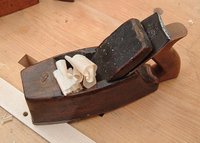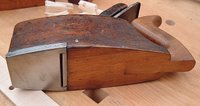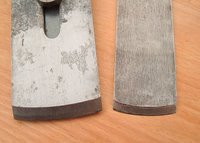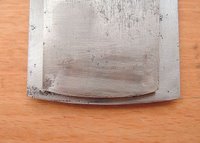 I started with the fanciest smoother. Well sort of. It's not actually cleaned, and its original Thomas Ibbotson iron is virtually worn down to the cap iron slot so I pinched a same-sized replacement from a less fancy smoother, but I did get the sole trued up and took it for a spin. Damned if I can get it set for as fine a shaving as I'd like, but it's probably worth the effort to try to improve that situation. As you can instantly see, it's not the norm of coffin smoothers, having a rear tote. I've had one designed for a tote for years, but this is the first one I've had with one actually fitted. I'm not a big fan of the coffin-smoother grip, so a tote is a major boon as far as I'm concerned. But wait, there's more...
I started with the fanciest smoother. Well sort of. It's not actually cleaned, and its original Thomas Ibbotson iron is virtually worn down to the cap iron slot so I pinched a same-sized replacement from a less fancy smoother, but I did get the sole trued up and took it for a spin. Damned if I can get it set for as fine a shaving as I'd like, but it's probably worth the effort to try to improve that situation. As you can instantly see, it's not the norm of coffin smoothers, having a rear tote. I've had one designed for a tote for years, but this is the first one I've had with one actually fitted. I'm not a big fan of the coffin-smoother grip, so a tote is a major boon as far as I'm concerned. But wait, there's more... The toe has a movable iron shoe. At least I assume it's movable. It's a bit rusted... I'm loathed the risk removing the wood to allow the mouth to be closed up more, simply 'cos I'm not familiar enough with this "improvement" to know if it'd work. But it does give some extra heft to the front of the plane, which I like. Judging by the worn state of that original iron, but the pretty good condition of the body (discounting the paint splatters) Mr W S Hosken liked it too. The Ward & Payne iron in it now is as hard as nails; took me an age to grind a new bevel; so it should have many more years of use in it.
The toe has a movable iron shoe. At least I assume it's movable. It's a bit rusted... I'm loathed the risk removing the wood to allow the mouth to be closed up more, simply 'cos I'm not familiar enough with this "improvement" to know if it'd work. But it does give some extra heft to the front of the plane, which I like. Judging by the worn state of that original iron, but the pretty good condition of the body (discounting the paint splatters) Mr W S Hosken liked it too. The Ward & Payne iron in it now is as hard as nails; took me an age to grind a new bevel; so it should have many more years of use in it. So with that success, I turned to the razee or technical jack plane. I'd already cleaned it up previously, but the sole needed jointing and the iron grinding and honing. Again, in the PWW special, Chris Schwarz mentions as coarse a blade camber as 8" on a jack plane blade - for rough work, natch. Jim Kingshott demonstrates his wooden jack was set up to take "shavings as thick as a soldier's belt" and I've long felt I should try a "proper" jack plane grind and see if scrubs are really necessary, so I decided to give it a shot.
So with that success, I turned to the razee or technical jack plane. I'd already cleaned it up previously, but the sole needed jointing and the iron grinding and honing. Again, in the PWW special, Chris Schwarz mentions as coarse a blade camber as 8" on a jack plane blade - for rough work, natch. Jim Kingshott demonstrates his wooden jack was set up to take "shavings as thick as a soldier's belt" and I've long felt I should try a "proper" jack plane grind and see if scrubs are really necessary, so I decided to give it a shot. Above; the jack iron (2" Marples) on the left, Stanley #40 1/2 on the right, with a 3" camber.On the right, one above the other to better show the difference. It's quite a mighty bite - I started to wonder if I hadn't made a terrible mistake. After all, I'm only a weedy girlie... Oh well, might as well try it now. I must admit I do like these extreme cambered blades; using a honing guide just complicates things, which gives me a smug inner glow as I hone them freehand. And I got it plenty sharp - I know that 'cos of the blood...
Above; the jack iron (2" Marples) on the left, Stanley #40 1/2 on the right, with a 3" camber.On the right, one above the other to better show the difference. It's quite a mighty bite - I started to wonder if I hadn't made a terrible mistake. After all, I'm only a weedy girlie... Oh well, might as well try it now. I must admit I do like these extreme cambered blades; using a honing guide just complicates things, which gives me a smug inner glow as I hone them freehand. And I got it plenty sharp - I know that 'cos of the blood... So having a bit of plane playtime, I found I could really only adequately manage a cut of about an inch in width, and momentum is everything. I don't play about with wooden planes nearly enough to say this or that is the case, but I do find my planing style changes when I use them. Velocity becomes important, presumably to make up for the lack of weight? But thick, scrub-like chips came flying out, and it wasted the wood at frightening speed. Vey satisfactory.
So having a bit of plane playtime, I found I could really only adequately manage a cut of about an inch in width, and momentum is everything. I don't play about with wooden planes nearly enough to say this or that is the case, but I do find my planing style changes when I use them. Velocity becomes important, presumably to make up for the lack of weight? But thick, scrub-like chips came flying out, and it wasted the wood at frightening speed. Vey satisfactory. Now the funny thing is BugBear took the time to convert a razee jack into a scrub. He did the thing properly; "proper" scrub camber, radius to the mouth, the works. At the time I did wonder what made it a "scrub" and not a "coarse jack". To be honest, I'm wondering even more now. Heck, it looks like the mouth opening's finer on his! Could this explain the absence of many scrub planes in the British market? The wooden jack held on much, much longer here and there must have been plenty of worn ones about that instantly lent themselves to use as a very coarse jack - and with zero effort. Why would you buy a dedicated plane for the task? Especially a metal Stanley, which really only appeared after the trend towards more machinery-prepared stock had already started anyway. I dunno, it's just a WAG on my part, but wouldn't it make sense if the wooden plane factor was the difference?
Now the funny thing is BugBear took the time to convert a razee jack into a scrub. He did the thing properly; "proper" scrub camber, radius to the mouth, the works. At the time I did wonder what made it a "scrub" and not a "coarse jack". To be honest, I'm wondering even more now. Heck, it looks like the mouth opening's finer on his! Could this explain the absence of many scrub planes in the British market? The wooden jack held on much, much longer here and there must have been plenty of worn ones about that instantly lent themselves to use as a very coarse jack - and with zero effort. Why would you buy a dedicated plane for the task? Especially a metal Stanley, which really only appeared after the trend towards more machinery-prepared stock had already started anyway. I dunno, it's just a WAG on my part, but wouldn't it make sense if the wooden plane factor was the difference?We'll draw a veil over the fact that the very tool chest the jack came from also contained the Stanley #40 1/2... You've heard of the exception to prove the rule? ;~)
 Anyway, I didn't take the time to do an arty shot, but here are the resultant chips up close and personal. Don't you just love the sound of crunchy shavings beneath your feet in the morning? And the afternoon. Well anytime really... :~)
Anyway, I didn't take the time to do an arty shot, but here are the resultant chips up close and personal. Don't you just love the sound of crunchy shavings beneath your feet in the morning? And the afternoon. Well anytime really... :~)
Know what you mean about woodies-you tap the iron into postion, test it, too fine. Tap, tap, test, too coarse. And so on..... ;)
ReplyDeleteThe Jack and the Scrub. Two different planes or just planes with the same function?? The name seems to stay the same but the plane changes depending on the tradesman. Think you got it sussed though!
So you don't need your thickness planer anymore then?? ;)
Philly
Sliding down that extreme camber slope, eh? :) Try putting a real camber (1 1/2" - 2" radius) on that #40 1/2. Then follow the scrub with your jack.
ReplyDeleteYou'll like the latest issue of Pop Wood as Chris Schwarz does an article on woody & metal planes. He doesn't call his coarse jack a jack but uses the term "fore plane" as Moxon did (sorry but I can't call a #5 a "fore plane"). He does a good job describing the "try" and "jointer" planes. :)
Phil, if I thought I had the nerve to dispense with the P/T, I'd be thrilled -it'd mean I'd have no reason to keep the Maxi any more! Alas, the flesh is weak, and so's the spirit if it comes to that... I'd sooner do the fun bits than the stock prep drudgery.
ReplyDeleteRoger, I was thinking of our previous discussion when I wrote that :~) Dunno about the greater radius on the scrub though - I'm not preparing stock from raw trees :~P And is that Feb's PWW? Still waiting on December's, so when I'll read that is anyone's guess :~(
Ever since I read Anthony Guidice's book "The Seven Essentials of Woodworking", I've felt guilt that I didn't own a scrub plane. And he claims that his students were never capable of converting a smoother or a jack to a scrub. But I'm sure you're right, Alf. Many a hard-worn jack must have eked out its final days as a pseudo scrub. As the mouth got bigger and the iron got more radiused through years of hand grinding and honing, it's a natural development. Almost a Darwinian evolution, you might say.
ReplyDeleteNow the funny thing is BugBear took the time to convert a razee jack into a scrub. He did the thing properly; "proper" scrub camber, radius to the mouth, the works. At the time I did wonder what made it a "scrub" and not a "coarse jack".
ReplyDeleteIt has become self-evident there's a continuum from a jack tuned to be a 16" smoother to a conventional (e.g. ECE horned, or Stanley #40) scrub.
An old, wide mouthed jack has started down the road.
Put more camber on the blade and you're further down.
Lose the cap iron...
I think your rough jack is only one stage behind mine on the road - I went single ironed.
I had to open the mouth, your "donor" was already there.
Neither of us can have a narrow blade in a narrow body.
If people don't want to call my (converted) plane a scrub, that's
fine too. What people call it doesn't alter the rate it removes stock :-)
BugBear